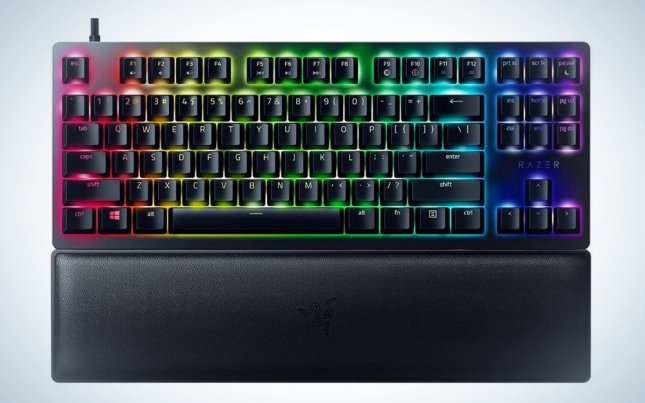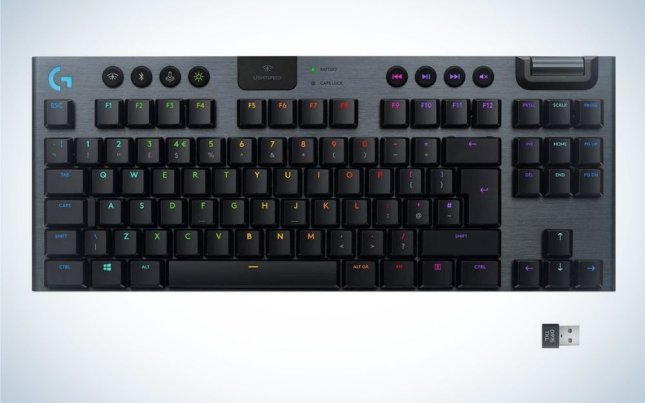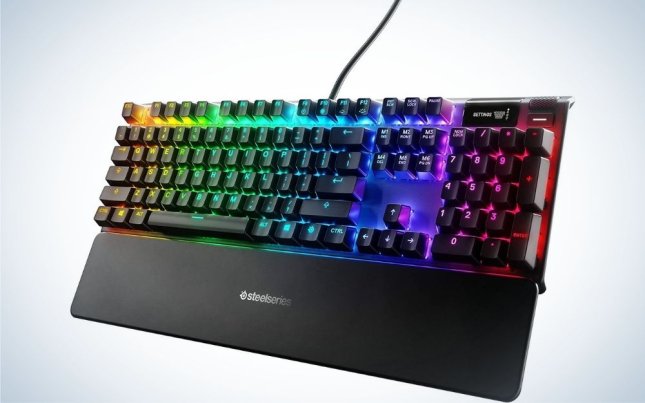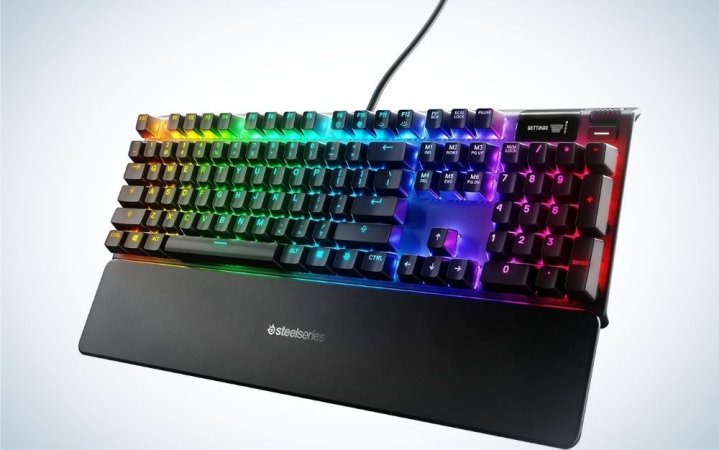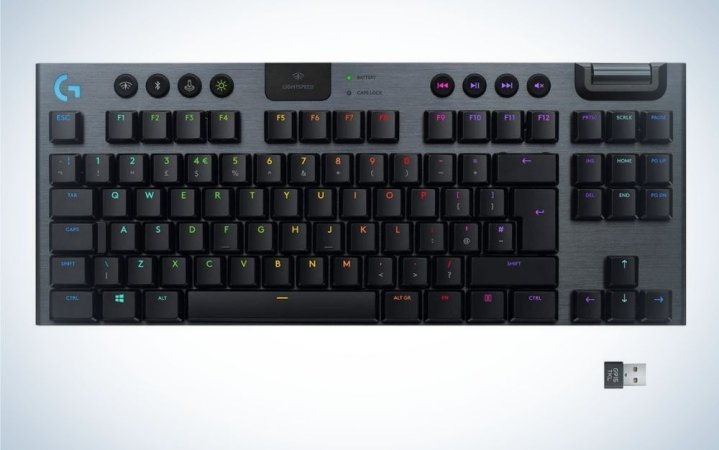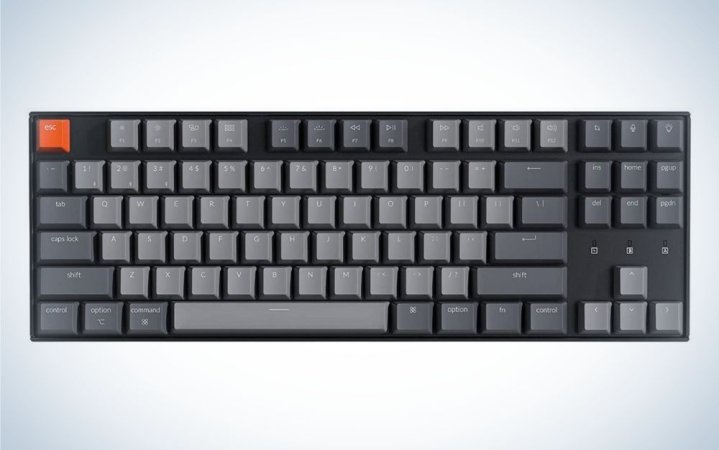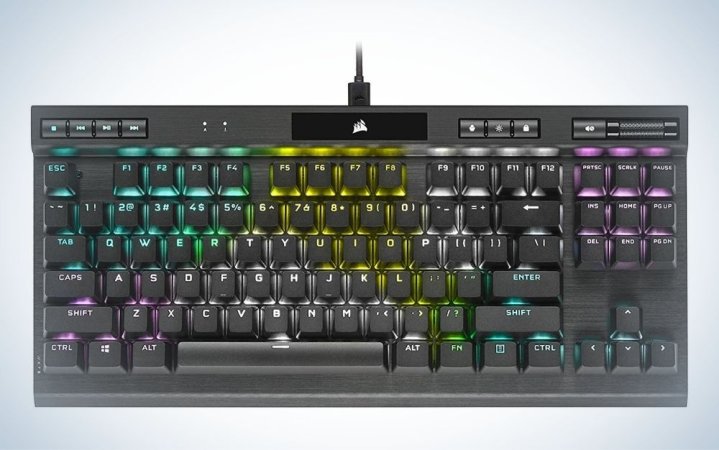We may earn revenue from the products available on this page and participate in affiliate programs. Learn more ›
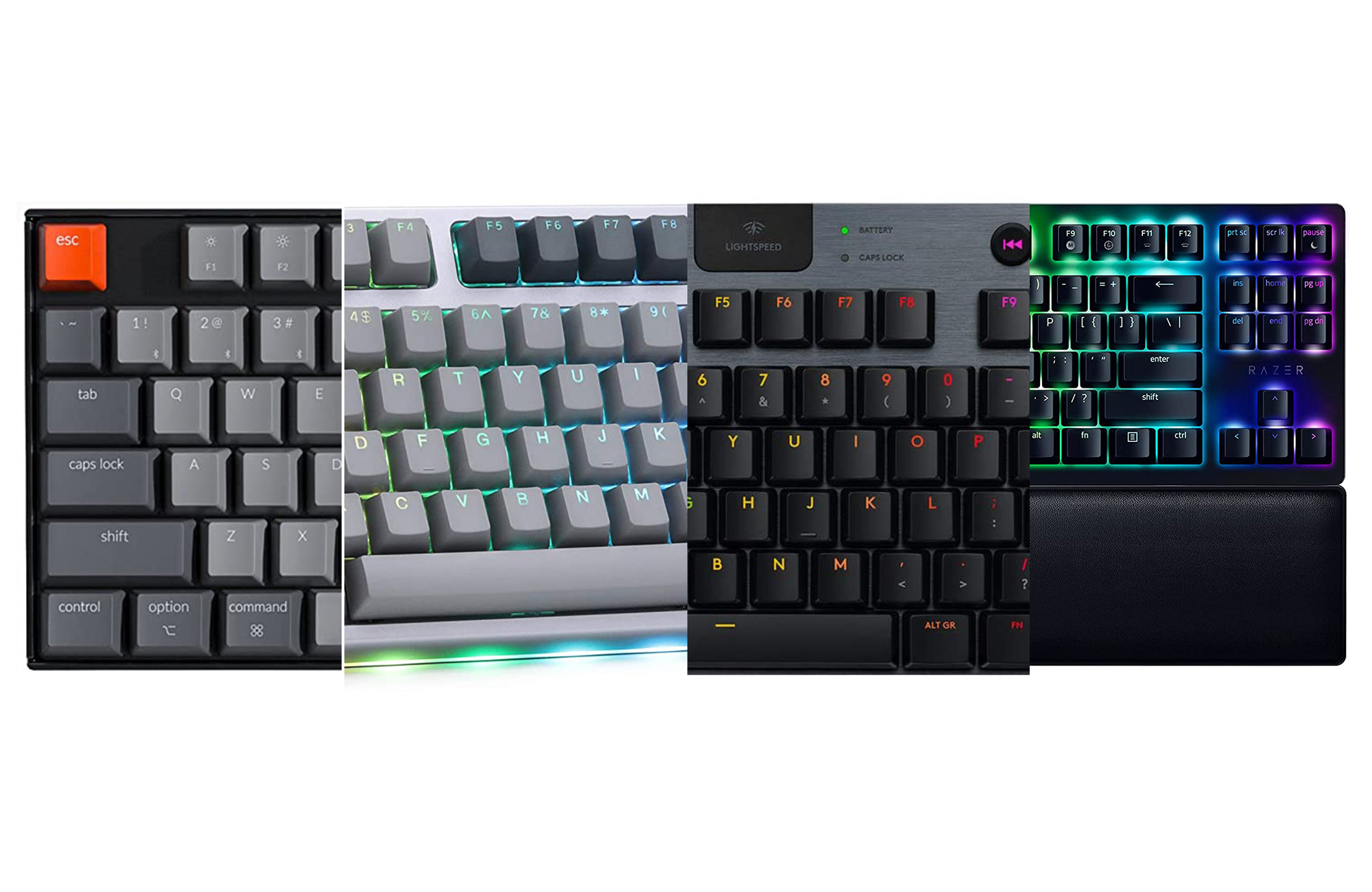
Tenkeyless, or TKL, keyboards are the “Goldilocks” size for most people. Striking a balance between standard, 104-key keyboards and compact 60% designs, the TKL looks and feels like full-size boards but with the number pad sliced off the right side. The balance between easy typing and a smaller desk footprint makes TKL keyboards an ideal option for gamers, writers, or programmers looking to free up their desk space without sacrificing helpful navigational keys. Though not as widespread as the full-size board, there’s a large number of TKL keyboards out there, especially for gaming. In many cases, you can even find TKL versions of popular full-size models. All those options, though, make comparing and shopping a bit of a chore. Luckily, our guide to the best TKL keyboards has everything you need to get something great.
- Best overall: Razer Huntsman V2 TKL
- Best for gaming: SteelSeries Apex Pro TKL
- Best wireless: Logitech G915 Lightspeed
- Best with hot-swappable switches: Drop CTRL
- Best for Mac: Keychron K8
- Best budget: Corsair K70 RGB TKL Champion Series
How we chose the best TKL keyboards
After a lifetime of PC gaming, several years as a professional writer, and dabbling in game development and media production, I’ve touched more keyboards than I can count. I’m also keenly aware a great gaming keyboard may not be a great choice for office work, for example, and there are features programmers need that writers would never touch. Our list of the best TKL keyboards reflects my own professional and personal experiences, and the understanding that some tasks require different keyboard features.
We found our selections for the best TKL keyboards through hands-on testing, research, and reviews from colleagues and trusted sources. They were judged on several factors, including price, durability, ergonomics, connection options, and typing experience. We also considered each product’s viability for playing games, writing, and programming.
The best TKL keyboards: Reviews & Recommendations
Now that you’ve had a crash course in keyboard picking, let’s look at the best TKL keyboards you can buy right now. As we mentioned, many of these models are intended for gaming-focused PCs, but all of them are strong picks for any type of typist.
Best overall: Razer Huntsman V2 TKL
Best TKL keyboard
A true “all-rounder.”

Pros
- Smooth, responsive typing experience
- Sound-damping foam for quiet keystrokes
- Full macro programming for each key
- Includes wrist pad
Cons
- Larger keys have a slight wobble
- High polling rate modes may impact CPU performance
Buy it used or refurbished: eBay
Why it made the cut: The Razer Huntsman V2 TKL is one of those rare “jack-of-all-trades” devices that manages to (mostly) overcome the “master-of-none” curse.
Specs
- Switches: Razer Click or Razer Linear optical switches
- Keycaps: Doubleshot PBT
- Connectivity: Wired USB
- Backlighting: RGB per-key
- Volume Roller: No
- Special features: Extremely high 8000Hz polling, Detachable wrist rest
- Price: $138
The Huntsman V2 TKL is a surprisingly balanced gaming keyboard that works well for gaming, productivity, and everyday typing. Like most gaming keyboards, you can configure any key, customize RGB lighting, and program macros using Razer’s Synapse 3 desktop app. The PBT doubleshot keycaps ensure that its lettering will never fade. It even ships with a detachable wrist pad.
But its best feature is the super-responsive typing performance. This wired keyboard features Razer’s proprietary optical switches, with the choice of either Razer Click switches for clicky (but not clacky) stab feedback, or second-gen Razer Linear switches that offer a quick, silent press. The kicker, which makes it stand out for non-gamers, is its built-in sound-dampening foam that reduces the typing noise that makes mechanical keyboards hard to use considerately in the workplace.
The Huntsman V2 also features the ability to set an ultra-high 8,000Hz polling rate, which Razer has added to some of its esports-facing gear. Polling rate, like refresh rate for TVs and monitors, refers to the number of times your mouse or keyboard sends signals to your PC. Standard 1,000Hz polling sends a signal approximately once a millisecond (ms). At 8,000Hz, Razer claims the Huntmans V2 can send signals with only 0.2ms of input lag. That higher performance comes at a cost, however: Using that high setting can lightly tax your PC in a way that using most keyboards simply does not.
Luckily, you don’t have to use 8,000Hz polling to enjoy using the Razer Huntsman V2 TKL. It is simply a snappy, easy-typing keyboard that can work wonders for anybody.
Best for gaming: SteelSeries Apex Pro TKL
Best TKL gaming keyboard
Any Switch, Any Style
Pros
- Adjustable actuation switches
- Detachable magnetic wrist rest
- Customizable OLED display
Cons
- ABS keycaps can wear out, long-term
- Expensive
Buy it used or refurbished: Amazon
Why it made the cut: SteelSeries’ Apex Pro TKL can be customized to match your specific gaming preferences and playstyle.
Specs
- Switches: SteelSeries OmniPoint
- Keycaps: ABS
- Connectivity: Wired USB
- Backlighting: RGB Per-key
- Volume roller: Yes
- Special features: OLED display, detachable wrist rest, USB passthrough
- Price: $146
The SteelSeries’ Apex Pro is truly unique. Rather than picking a mechanical key type to create a specific feel, the Apex Pro features proprietary OmniPoint switches with adjustable resistance and actuation. Using SteelSeries’ Engine configuration software, you can change the feel of most keys whenever you want to fit your personal preferences for different tasks. The linear-style keys have a unique feel, which may be an acquired taste, but offer incredible utility for those who want to tinker and figure out exactly what they like.
The Apex Pro TKL also features a robust suite of luxury features for a TKL keyboard. It has a dedicated volume wheel for quick sound adjustments, USB passthrough, a detachable wrist rest, and an integrated OLED screen used to control the keyboard’s settings and can even display useful info for some games and apps. As with most gaming keyboards, SteelSeries Engine allows you to store multiple configuration profiles, adjust its RGB lighting, and more.
Frankly, many of the keyboards on this list are made for gaming, so if the Apex Pro’s unique approach seems risky, there are definitely plenty of great options. You aren’t going to find any keyboard quite like this one, though.
Best wireless: Logitech G915 Lightspeed
Best wireless TKL
Keep a Low Profile
Pros
- Long battery life, even with RGB turned on
- Low-profile switches feel good, even with less travel
- Multiple connection options
Cons
- Limited macro support
- Expensive
Buy it used or refurbished: Amazon
Why it made the cut: The Logitech G915’s sleek wireless design saves even more desk space than the average TKL keyboard.
Specs
- Switches: Logitech low-profile GL (tactile, linear, or clicky)
- Keycaps: ABS
- Connectivity: 2.4GHz wireless via USB dongle, Bluetooth, or USB Wired
- Backlighting: RGB Per-key
- Volume roller: Yes
- Special features: Volume roller, 5 dedicated macro keys, hot-swap among up multiple wireless connections
- Price: $189
For a mechanical gaming keyboard, the Logitech G915 Lightspeed looks shockingly sleek. A thin, 22mm slate covered with low-profile switches, it achieves an Apple-esque futuristic look that stands out as sharp and exciting.
Low-profile switches are shorter, which means they offer less “travel” or distance from unpressed to fully pressed down. Among mechanical keyboards, less travel usually equates to a less comfortable typing feel, but Logitech’s proprietary low-profile GL switches find a sweet spot between laptop keyboard quickness and a satisfying press.
The “lightspeed” in the Logitech G915’s name refers to Logitech’s proprietary wireless technology. It connects to your PC using a 2.4 GHz “Lightspeed” connection via a USB dongle but also supports Bluetooth wireless for non-gaming applications. As for battery life, you can expect around 40 hours of use on a single charge as long as you keep the per-key RGB lighting on, and turning it off will naturally boost your use time.
Ultimately, the Logitech G915 Lightspeed is an outstanding wireless mechanical gaming keyboard that defies convention and looks good doing it. Whether it’s worth over $200—an extremely high price for a TKL—is up to you.
Best with hot-swappable switches: Drop CTRL
Best TKL with Hot-Swappable Switches
Mechanical Chameleon
Pros
- Swappable switches
- PBT keycaps
- Great typing feel whether or not you bring your own switches
Cons
- Cumbersome macro programming
Buy it used or refurbished: eBay
Why it made the cut: The Drop CTRL offers a fantastic typing experience out of the box, but allows for enthusiast customization.
Specs
- Switches: Halo Clear or Halo True; Hailua Speed; Cherry MX
- Keycaps: Doubleshot PBT
- Connectivity: Wired USB
- Backlighting: RGB Per-Key
- Volume roller: No
- Special features: Dual USB-C connectors, removable feet
- Price: $270
Drop, a social marketplace for deals and user-requested gear designs, has a lot to offer for enthusiast keyboard fans. If you like to build your own keyboards, or modify them with custom keycaps and switches, it has a wealth of resources to purchase. Not all keyboards are built to let you “hot-swap” or install new switches without taking your keyboard apart. As you might expect, Drop’s pre-built options do, and they make it pretty easy.
As an enthusiast’s keyboard, the CTRL is more focused on aesthetics and pure typing feel, rather than other features. Unlike the gaming keyboards on this list, you can only customize your configuration using a clunky web-based tool.
Still, the Drop CTRL has an incredible typing feel, even if you don’t touch the switches. You have the option to play around, but you’re getting a winner even if you don’t touch a thing.
Best for Mac: Keychron K8
Best TKL keyboard for Mac
Because chiclets are for chewing, not typing.
Pros
- Options for quieter mechanical switches
- Adjustable typing angle
- Supports Mac, Windows, Linux, iOS, iPad, and Android.
- Hot-swappable switches (on some models)
Cons
- No macro support
- Limited functionality on mobile devices
Buy it used or refurbished: Amazon
Why it made the cut: The Keychron K8 supports many devices and operating systems that other mechanical keyboards often overlook.
Specs
- Switches: Gateron G Pro, Gatreon Optical
- Keycaps: ABS
- Connectivity: Bluetooth wireless or wired USB
- Backlighting: RGB (15 patterns), or white
- Volume roller: No
- Special features: wireless connection to multiple devices, keycaps for Mac and Windows layouts
- Price: $80
Apple sells a compact version of its Magic Keyboard, but there are better options out there for Mac typists. If you want to go mechanical on Mac, the Keychron K8 lets you replace those chiclet keys with something that has a little more travel.
Its sleek and simple design will fit perfectly in any office. Meanwhile, a wide array of configurations are for sale, ensuring you can buy a keyboard that fits your preferences. There are Keychron K8 models with six types of mechanical and optical switches, optional switch hot-swapping support, and RGB or white-only backlighting.
We wouldn’t restrict the Keychron K8 to just Mac users, however. It’s also a decent all-rounder for Windows, and even has partial support for Linux, iOS, iPad, and Android devices. It’s a simple keyboard without any notable special features, but it has a good typing feel and a great, sub-$100 price.
Best budget: Corsair K70 RGB TKL Champion Series
Best Budget TKL keyboard
Well-Priced, Not “Cheap”
Pros
- 8000Hz polling rate
- Dedicated “Tournament Mode” switch
- Media keys and volume roller aren’t common on TKLs
Cons
- Esports specialization may not be for everyone
Buy it used or refurbished: Amazon
Why it made the cut: The Corsair K70 Champion Series packs high-end specs and features at a mid-range price.
Specs
- Switches: Cherry MX
- Keycaps: Doubleshot PBT
- Connectivity: Wired USB
- Backlighting: RGB per-key
- Volume roller: Yes
- Special features: Esports “tournament mode,” media keys, 8,000Hz polling
- Price: $109
The Corsair K70 RGB TKL is not the cheapest best TKL keyboard you can find, but it is a very strong value for its price. It features lots of little amenities, ranging from common TKL upgrades like PBT keycaps and customizable RGB lighting, to less common flourishes like built-in media buttons and a volume roller.
The Corsair K70 RGB TKL Champion Series is an esports keyboard, not just a gaming keyboard, so it also has features like 8,000Hz polling and a tournament mode switch, which temporarily turns off custom macros and other features that may interfere during official competitive play. That may seem frivolous for some, but its other quality-of-life features are novel and great for any gamer.
What to consider before buying the best TKL keyboards
The best TKL keyboards don’t vary that much from other keyboard form factors, so picking your next one won’t be much different than picking any type of the best keyboards. The most important question is whether you actually want a TKL design. The Tenkeyless falls right in the middle between 60 percent keyboards and full-size models and usually has around 87 keys. In terms of saving space, they are much narrower than a full-size keyboard but aren’t as small as a compact design. On the other hand, they retain the full-size keyboard’s spacing, so they’re arguably easier to navigate. If you like the way your full-size keyboard feels, but can confidently say you never use your Numpad, then switching to a TKL is probably a good move.
Picking your switches
When picking a keyboard, any shape or size, it’s important to think about typing feel, which means thinking about how your keys work. Like many keyboard enthusiasts, we tend to prefer mechanical keyboards, which use a physical spring and switch to operate the keys. As a gaming-focused keyboard sub-genre, you’ll find that the vast majority of TKLs feature mechanical keys.
When you pick a mechanical keyboard, you often also need to pick the kind of key switches it uses. The switch you choose will impact how much force you need to use to activate and/or fully depress a key, as well as how far down you need to press a key to actuate it, or send a signal from the keyboard to your device. There are also differences in feel and even sound that enthusiasts may prefer.
Key switch types are normally color-coded. While the nuances vary from switch manufacturer to manufacturer, there are three core categories: Linear (often “Red”), Tactile (“Brown”), or Clicky (“Blue”). Linear switches usually have the lightest touch and provide very little tactile response when you click them, so they’re preferred for competitive gaming. The tactile is the balanced option, emphasizing the “bump” you feel when actuating each key. Clicky switches are similar to tactile switches, but with a stronger emphasis on making a loud “clang” with each tap. There are many, many more options beyond these core three but most major manufacturers will offer at least one, if not all three, of these options.
In recent years, we’ve also started to see an influx in optical gaming keyboards, which use a laser to complete a circuit that actuates each key you press down. Manufacturers claim that optical keyboards minimize the already imperceivable amount of input lag in other keyboards. Companies also claim the switches may last longer.
We can’t tell you what switch will feel right. If you can’t head out to a store to try some keyboards with different switches, we recommend tactile switches for people who want a nice typing feel across gaming and work, or Red switches if you’re a competitive player who wants controls with a hair-trigger.
Connectivity
Even among TKLs, you will have the option to choose whether you want a wired or wireless keyboard. Wired keyboards are easy to set up, and never lose power. Wireless keyboards, however, give you more flexibility and keep your desk cable-free.
If you decide to get a wireless keyboard, make sure you look for one with strong battery life and connection options. For office work, any Bluetooth keyboard will do fine, but gamers will want to make sure and get a keyboard that comes with a 2.4 GHz wireless dongle, which ensures a more stable connection with minimal input lag. There are some competitive purists who will insist that you need a wired keyboard for gaming. In our experience, that is not the case.
FAQs
TKL keyboards, by definition, have 87 keys (though you may see some with a few more or less, depending on the design). The layout is identical to the standard “full-size” keyboard, but without the number pad section on the far right.
Technically, no, but they are very similar. Both TKL and 75 percent keyboards feature the same general range of keys but have different layouts. TKLs follow the design of the full-size keyboard, with gaps between certain sets of keys. The 75 percent layout compressed all of the keys into a single block, similar to 60 percent keyboards. The 75 percent design should be smaller than a TKL, but some users may find the design feels cramped, despite being only a tad bit smaller.
Neither the TKL nor the 60 percent keyboard is objectively “better” than the other. They are simply different sizes, with their own distinctive feels. Both TKL and 60% keyboards are smaller than a full-size keyboard and lack the Numpad keys. The 60 percent design cuts the layout down, even more, nixing the function row, arrows, and other keys.
Each person’s exact typing experience depends on ergonomic factors like keyboard angle, switch sensitivity, wrist support, and even keycap material which vary between models. All that said, some people feel that TKL models are easier to center on your desk for even hand placement, and provide more room for your mouse or other peripherals.
Final thoughts on the best TKL keyboards
- Best overall: Razer Huntsman V2 TKL
- Best for gaming: SteelSeries Apex Pro TKL
- Best wireless: Logitech G915 Lightspeed
- Best with hot-swappable switches: Drop CTRL
- Best for Mac: Keychron K8
- Best budget: Corsair K70 RGB TKL Champion Series
If you can part with your number pad, the best TKL keyboards balance the wide functionality of a full keyboard and the space-saving efficiency of more compact designs. It is a smart way to free up some desk space for an equally optimized gaming mouse (or ergonomic one) or complement a mobile work setup.
